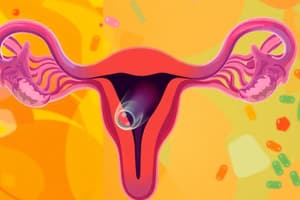Podcast
Questions and Answers
Which of the following best describes the primary anatomical components of the female reproductive system relevant to vaginal drug delivery?
Which of the following best describes the primary anatomical components of the female reproductive system relevant to vaginal drug delivery?
- Uterus, cervix, ovaries, and Bartholin's glands.
- Uterus, fallopian tubes, ovaries, cervix, ectocervix, and vagina. (correct)
- Uterus, fallopian tubes, ovaries, and mammary glands.
- Vagina, vulva, clitoris, and perineum.
Why is the vaginal route considered advantageous for drug administration compared to oral administration?
Why is the vaginal route considered advantageous for drug administration compared to oral administration?
- It bypasses the hepatic first-pass metabolism. (correct)
- It guarantees higher patient compliance.
- It completely avoids the possibility of local irritation.
- It ensures faster drug absorption due to higher enzymatic activity.
In which therapeutic area is vaginal drug delivery commonly utilized due to its effectiveness and local action?
In which therapeutic area is vaginal drug delivery commonly utilized due to its effectiveness and local action?
- Respiratory ailments
- Vaginal infections (correct)
- Cardiovascular diseases
- Neurological disorders
What is a major disadvantage associated with vaginal drug delivery?
What is a major disadvantage associated with vaginal drug delivery?
Which of the following is the primary mechanism by which lipophilic drugs are absorbed in the vagina?
Which of the following is the primary mechanism by which lipophilic drugs are absorbed in the vagina?
Which factor significantly affects vaginal drug delivery due to its influence on drug ionization and absorption?
Which factor significantly affects vaginal drug delivery due to its influence on drug ionization and absorption?
What role do penetration enhancers play in vaginal drug formulations?
What role do penetration enhancers play in vaginal drug formulations?
What property of polymers is most important when designing a vaginal drug delivery system for prolonged drug release?
What property of polymers is most important when designing a vaginal drug delivery system for prolonged drug release?
Which of the following dosage forms is designed for local drug delivery in the vagina?
Which of the following dosage forms is designed for local drug delivery in the vagina?
What is a characteristic of systemic drug delivery via the vaginal route?
What is a characteristic of systemic drug delivery via the vaginal route?
Which of these factors influences the rate and extent of drug absorption after intravaginal administration?
Which of these factors influences the rate and extent of drug absorption after intravaginal administration?
How do amylases, present in the vaginal environment, influence drug delivery?
How do amylases, present in the vaginal environment, influence drug delivery?
Why is a bio-adhesive property important for polymers used in vaginal drug formulations?
Why is a bio-adhesive property important for polymers used in vaginal drug formulations?
What is the rationale behind using mucoadhesive agents in vaginal drug delivery systems?
What is the rationale behind using mucoadhesive agents in vaginal drug delivery systems?
How does the molecular weight of a drug (API) influence its absorption through the vaginal route?
How does the molecular weight of a drug (API) influence its absorption through the vaginal route?
Which of the following is an example of a therapeutic application for vaginal drug delivery?
Which of the following is an example of a therapeutic application for vaginal drug delivery?
A drug's partition coefficient (lipophilicity) is a physicochemical factor that affects vaginal drug delivery. How does a higher partition coefficient typically influence drug absorption?
A drug's partition coefficient (lipophilicity) is a physicochemical factor that affects vaginal drug delivery. How does a higher partition coefficient typically influence drug absorption?
What is the function of proteolytic enzymes present in cervical mucus?
What is the function of proteolytic enzymes present in cervical mucus?
How does the use of vaginal douches impact the effectiveness of vaginally administered drugs?
How does the use of vaginal douches impact the effectiveness of vaginally administered drugs?
What consideration guides the selection of polymers for vaginal drug delivery concerning the local environment?
What consideration guides the selection of polymers for vaginal drug delivery concerning the local environment?
Flashcards
Female Reproductive System
Female Reproductive System
Female reproductive system composed of the uterus, fallopian tubes, ovaries, cervix, ectocervix, and vagina.
Vaginal Composition
Vaginal Composition
Stratified epithelium, lamina propria, fibromuscular layer, and adventitia; covered by cervical mucus.
Vaginal Drug Delivery Advantage
Vaginal Drug Delivery Advantage
A route of drug administration bypassing first-pass metabolism.
Vaginal Delivery Applications
Vaginal Delivery Applications
Signup and view all the flashcards
Therapeutic Applications
Therapeutic Applications
Signup and view all the flashcards
Advantages of Vaginal Route
Advantages of Vaginal Route
Signup and view all the flashcards
Disadvantages of Vaginal Route
Disadvantages of Vaginal Route
Signup and view all the flashcards
Transcellular Drug Absorption
Transcellular Drug Absorption
Signup and view all the flashcards
Paracellular Drug Absorption
Paracellular Drug Absorption
Signup and view all the flashcards
Physiological Factors
Physiological Factors
Signup and view all the flashcards
Physicochemical Factors
Physicochemical Factors
Signup and view all the flashcards
Formulation Factors
Formulation Factors
Signup and view all the flashcards
Penetration Enhancers
Penetration Enhancers
Signup and view all the flashcards
Mucoadhesive Agents
Mucoadhesive Agents
Signup and view all the flashcards
Bio-adhesive Formulations
Bio-adhesive Formulations
Signup and view all the flashcards
Bio-adhesive/mucoadhesive properties
Bio-adhesive/mucoadhesive properties
Signup and view all the flashcards
Local Drug Delivery Systems
Local Drug Delivery Systems
Signup and view all the flashcards
Systemic Drug Delivery Systems
Systemic Drug Delivery Systems
Signup and view all the flashcards
Study Notes
- Vaginal drug delivery involves various routes of administration, including ocular, nasal, buccal, sublingual, oral, transdermal, parenteral, pulmonary, rectal, and vaginal.
Learning Objectives
- Understanding the anatomy and physiology of the vagina.
- Discussing drug delivery methods via the vagina.
- Listing four therapeutic applications of vaginal drug delivery.
- Listing three advantages and three disadvantages of vaginal drug delivery.
- Discussing two mechanisms of vaginal drug absorption.
- Describing three key factors that affect vaginal drug delivery.
- Describing three formulation factors that affect vaginal formulations.
- Discussing properties of polymers used in vaginal drug delivery.
- Identifying systemic and local drug delivery through the vaginal route.
- Listing different types of dosage forms for vaginal drug delivery.
Vagina: Anatomy and Physiology
- The female reproductive system consists of the uterus, fallopian tubes, ovaries, cervix, ectocervix, and vagina.
- The vagina comprises stratified epithelium, lamina propria, a fibromuscular layer, and adventitia, covered by cervical mucus that facilitates drug absorption.
- Cervical mucus protects against infections and is constantly renewed.
- Cervical mucus is about 90% water, urea, carbohydrates, mucins, fatty acids, salts, and proteolytic enzymes.
Drug Delivery Through Vagina
- The vagina is favorable for drug administration due to the avoidance of first-pass effects, rich vascularization, and relatively low enzymatic activity.
- The vaginal cavity suits noninvasive, controlled transmucosal delivery for local (antifungals, steroids, antimicrobials, nonoxynol-9) and systemic effects (ovulation induction, urogenital infections, hormone replacement).
- Vaginal pH, enzyme activity, and microflora affect formulation retention, absorption, and drug release.
Vaginal Drug Delivery: Therapeutic Applications
- Effective for delivering hormones in contraceptives.
- Used to treat Acquired Immune Deficiency Syndrome(AIDS)/HIV.
- Applicable in treating sexually transmitted diseases (STDs).
- Effective against vaginal infections like vaginosis and trichomoniasis.
Advantages of Vaginal Drug Delivery
- Avoids hepatic first-pass metabolism.
- Has minimal systemic side effects.
- Enables the local targeting of drugs to reproductive organs.
Disadvantages of Vaginal Drug Delivery
- Patient noncompliance is a factor.
- There is potential for local irritation.
- Drug absorption varies with menstrual cycle, menopause, and pregnancy.
Drug Absorption Mechanism
- Drugs are absorbed in the vagina through two primary routes.
- Transcellular: Transfer across cells (from apical to basal membrane), used for lipophilic drugs.
- Paracellular: Transport between cells via tight junctions, employed for hydrophilic drugs.
Key Factors Affecting Vaginal Drug Delivery
- Physiological factors: acidic pH (3.5–4.5), enzymes (e.g., amylases), cyclic changes, and hormone levels.
- Physicochemical factors: molecular size, weight, partition coefficient (lipophilicity), ionization, and chemical nature of the API.
- Formulation factors: viscosity, penetration enhancers, and bio-adhesive/mucoadhesive properties.
Formulations: Factors Affecting Vaginal Formulation
- Penetration Enhancers: Promote drug absorption through the vaginal mucosa; for example, bile salts enhance penetration by interacting with phospholipids in cell membranes.
- Mucoadhesive Agents: Ensure close contact with the vaginal mucosal surface by promoting adherence; for example, hyaluronic acid and cellulose derivatives.
- Bio-adhesive Formulations (Polymer): Deliver the API over an extended period at a predictable rate; for example, carbomers and polycarbophil.
Properties of Polymers
- Polymers can have properties like swelling, viscosity, stimuli-responsiveness, mucoadhesion, prolonged residence time, antimicrobial activity, biodegradability, and controlled drug release.
Systemic and Local Drug Delivery Systems
- Local Drug Delivery Systems: vaginal suppositories, douches (irrigation/sprays/solutions), gels, creams, films, patches, and rings.
- Systemic Drug Delivery Systems: tablets, capsules, injectables, and implants.
Studying That Suits You
Use AI to generate personalized quizzes and flashcards to suit your learning preferences.




